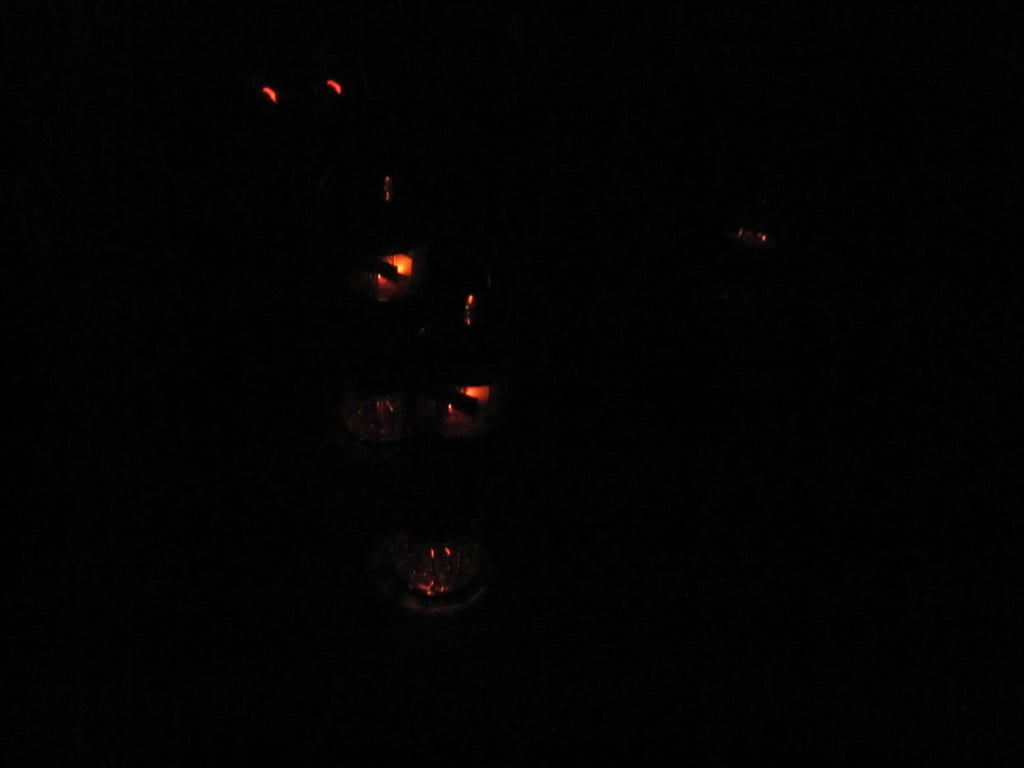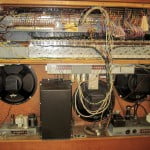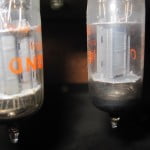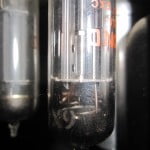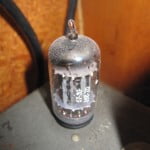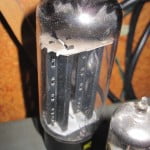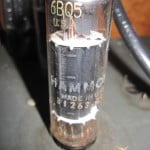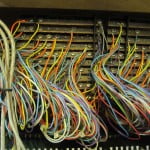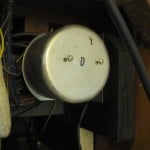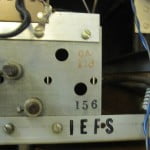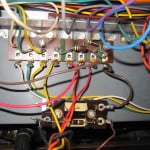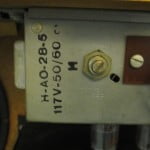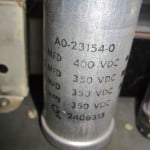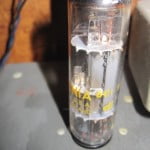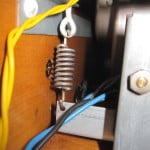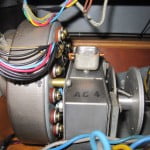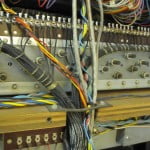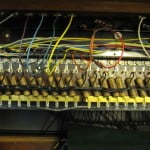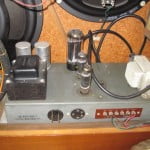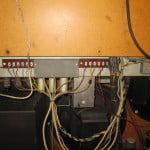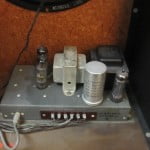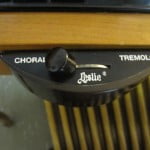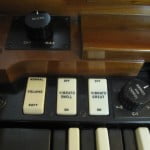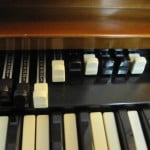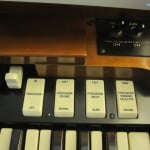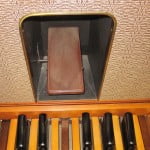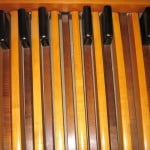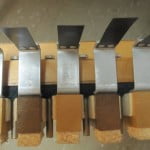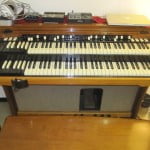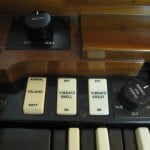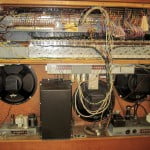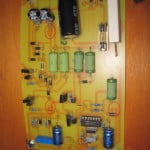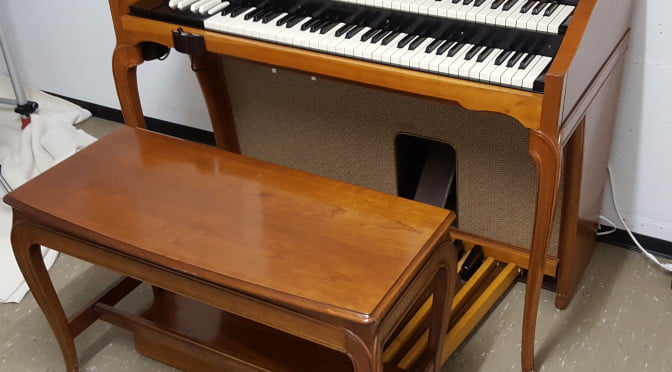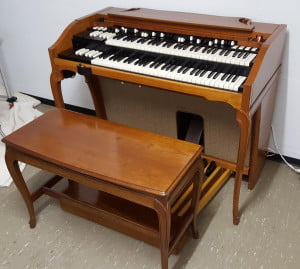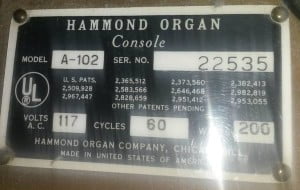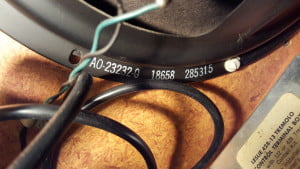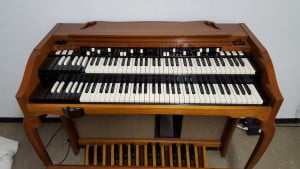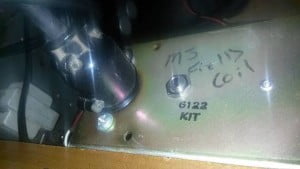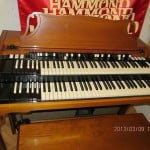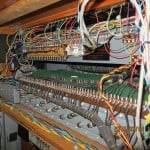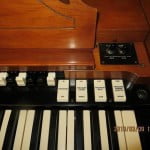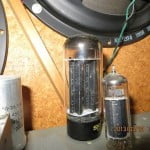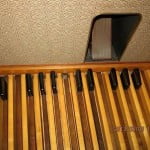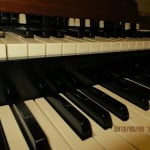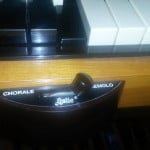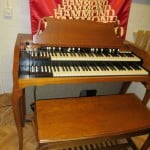On the portable side, here’s a nice video of the Elkatone 610, which I use if I want to bring a ‘Leslie’ out. Not quite the real thing, but spins the air just fine, and gives a much better 3D-effect than most simulators, especially the high rotor works very well. Crossover is different, and the lower speaker gets the full signal. Fits into the boot of my car, and works well with the hot output of a Nord C1.
Category Archives: Technical
Christmas time – Hammond console tubes glowing
Since it’s almost Christmas, here’s a seasonal picture of all the tubes in my Hammond glowing in the dark.
More pictures of my Hammond A-102
Today I took some pictures of the A-102.
Repairing an A-102 Hammond
Found some very useful images on the organ forum showing a number of repairs that were done to an A-102. Covered are the lifting of the manuals, replacement of a key, and many more repair instructions are available.
The Leslie 251
The Leslie 251 is a 2-channel Leslie that is the ideal fit for an A-100 series organ, since it has an additional channel to make use of the reverb amp that is found in the A-100.
Specifications
Dimensions: 41 ” high, 29 ” wide, 22 1/2 ” deep
Speakers: Rotary channel, treble -compression type driver, permanent magnet, 16 Ohms impedance
Rotary channel, bass – 15 inch heavy duty, permanent magnet, 16 Ohms impedance
Secondary channel, two wide range 6 x 9 permanent magnet speakers, 16 Ohms impedance each
Amplifier: Two channels, with combined output of 50 watts
Power consumption: 200 watts, 2.2 amps
How to hook up a 251 to a Hammond Model A-100 using Leslie-kit 8253
1. Attach the echo and tremolo controls to the wooden rail in front of the lower manual with the black oxide screws provided. Use two mounting screws in the rail. Make sure the organ is turned off for the following steps.
2. Remove the organ back and pass the control cables into the console by the following method:
Clip the red and green interceptor plugs and sockets off the echo control cable and strip the wires 3/8″. Push a small screwdriver over the felt dust seal between the lower manual and the knee panel. Push the cables through this opening into the console. From the back of the console, reach behind the tone generator and pull the cables through
3. Position the console connector near the power amplifier so that the power and control cables will reach. Install it with wood screws.
4. Cut the green lead which connects the amplifier output to the main speakers. Remove 3/8″ of the insulation from each of the cut ends. Connect the amplifier end of this lead to the red lead from the echo control with a wire nut. Connect the speaker end of the lead to the green lead from the echo control.
5. Disconnect the reverberation input lead (green) from the main speakers. Strip and connect it to the orange lead from the echo control with a wire nut.
6. Detach the “hot” lead (gray or blue) from the reverberation speaker terminal, strip it and connect it to the blue lead from the echo control with wire nut.
7. Solder the yellow echo control lead to the “hot” reverberation speaker terminal.
8. A100: Connect the plug from the console connector into the contact socket on the rear apron of the power amplifier chassis.
M100: Cut off the 5 -pin plug from the console connector and strip all three leads about 1/4″. Solder the brown cord to the outside AC-terminals under the metal cover on the left-hand side of the rear apron of the power amplifier. Fasten the red lead to any convenient ground point on the amplifier chassis.
9. Connect the brown lead from the echo control to the short, single, brown lead from the console connector, with wire nut.
10. Connect the black lead from the echo control to the black lead from the console connector, with wire nut.
11. Connect the brown double wire from the tremolo control to the short, double, brown wire from the console connector, with wire nuts.
12. Connect the speaker cable between the Leslie and the socket on the console connector.
13. Replace organ back
If the organ’s reverberation control does not work properly, reverse the gray and black leads (marked “Speaker”) on the reverberation amplifier terminals.
WARNING: the 251 connector uses the “6C” pin-out, which is distinct from either the 122-style or the 147-style single-channel pin-outs. Make sure you know how the connector is wired before you plug in that six-pin.
Inside the A-102
Jon Lord talks about his Hammond organ sound
Jon Lord (‘Deep Purple’) gives a demonstration on how he got his signature sound, and demonstrates it playing the organ solo from ‘Highway Star’.
The silent Hammond console – getting to a usable line level
The ‚Marriage made in heaven‘ for any Hammond tonewheel organ is the Leslie cabinet. The 122, 147 or 251 are probably the most common for consoles, many others are available. However, if you find yourself in a situation similar to mine where it is not possible to blast a Leslie at full tilt, there are other options to still enjoy playing your tonewheel. In this section I’ll explain the setups I’ve been experimenting with, and why I settled on my current setup.
Using a silent setup also makes it a lot easy to record the organ into a DAW, which is also part of my standard setup, and it avoids the tricky (and expensive, due to the need of three microphones) miking of the Leslie cabinet). I use this approach to record tracks for posting to Wikiloops.
First of all, to get a usable signal from your Hammond, you will need to install some kind of line-out. There a few ways to accomplish this that I know of:
The traditional method is to take a wire from one of the G-Terminals (there are two, any one will do) on the preamp and another one from ground, and attach them to a standard mono TR (guitar) cable. This will give you a signal that can be used to feed into a Leslie 3300 or a number of Leslie clones (it works well with my Elkatone 600). Unfortunately, this signal is much to ‘hot’ to feed into modern equipment like a Neo Ventilator.
Surprisingly, my interface had no problems with it, probably because it has a have a variable preamp-level adjustment. The interface I am using for this application is nothing special, a Steinberg CI2+ which has 2 inputs (2 x line/mic combo) and a switch / knob that can generate midi signals).
To be able to use modern pedals, like the aforementioned Neo Ventilator, you’ll have to pad the signal down to a more manageable level. This can be done by building what is known as the ‘Motion Sound’ line-out, which involves two resistors and a capacitor, or one resistor, a potentiometer and a capacitor for a variable level.
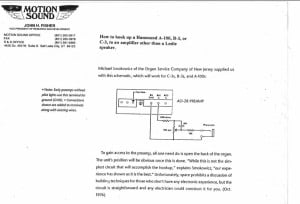
There is also a TREK II product available for this purpose, the VIB-3 Rotary Cabinet Simulator Interface.
As a quick fix, I used a cheap mixer I had lying around (Behringer MXB 1002), which worked fine to pad down my hot line-out to something more palatable to the Neo Ventilator II. The recommendation is to set the output level such that the red overload led on the ventilator lighs up, and then back it up ever so slightly to just stop this from happening. This gives good results, and pretty much makes a variable output adjustment a necessity to easily find the right level.
I’ve now switched to a small passive mixer (ART SplitMix4) since using a full mixer is really overkill, the ART brings the level down nicely to a standard line level and is completely passive, and does not introduce any noise.
I’ll discuss the next part of the chain in another post.
The Hammond A-100 Series tonewheel organ
A great site with a lot of information of the old tonewheel Hammond organs is Captain Foldback. More details on the A-100 can be found at A-100 – Best in its class
Overview
“The best B-3 is an A-100” – this is a statement occasionally found on the web. It seems to imply that a Hammond A-100 organ is really the same organ as the legendary B-3, with additional features added. The A-100 is often considered as the ‘home’ version of the B-3/C-3 tone wheel organs. The cabinets of the A-100 models were targeted for home use: no locking top, the addition of built-in speakers and reverb, and a wider selection of wood finishes and stylings. Today, the A-100 series organs have become increasingly sought after since they are usually well kept and less played than B/C-3 organs often owned by churches or professional musicians. The slimmer profile of the A-100 cabinet is often preferred over the B-style cabinet for taking it on the road, and makes it easier to get into a home by virtue of its smaller depth, which makes it easier to negotiate doors and corners.
History
The first A-100 organs were produced in in the USA in 1959. They used the necklace type reverb. The A-100 was the first tone wheel console to include a built-in reverb. In the early 60’s, different models of the A-100 featuring a different cabinet style were issued:
- Traditional A-100. Available in red mahogany and light walnut
- ‘Contemporary’ A-101. Available in grey and brown mahogany and translucent black
- French Provincial A-102. Available in dark and light cherry. Features curved front legs
- The C-3 cabinet was adapted to contain the A-100 speaker system, creating model A-105. Available in light oak and dark walnut. Has a back panel and a locking top
- The A-122 in Patina Walnut (from 1964). Available in aged walnut. A slightly modified version of the A-101
- The Early American A-143 (from 1964). Available in maple.
Leslie speakers were sold in matching colours and wood types, but not by the Hammond Company, they were sold directly by Don Leslie’s company, Electro Music.
The A-100 series was discontinued in 1965. The A-105 remained in production until the very last tonewheel organs were made in the mid 70’s. Since the A-105 was still around after 1965, the parts needed to make it , like the speakers, power amplifier and other core components were too, so A-100 series organs were being produced until 1975 in the U.K., Denmark, Belgium and Germany. The models produced under license in Europe were adapted to run using the locally prevalent 200V / 50Hz power supply.
My Hammond A-102
Type: Hammond A-102 (A-100 Series). US Model (117V).
Uses a converter to get from 220V / 50 Hz to the required 117V / 60 Hz.
Likely built in 1963. I figured this out using the information available on The Hammond/Leslie Age Determination List available at Tonewheel General
- Fluted vibrato knob – 1962 and older
- Small Hammond script (very much faded) – 1935 – 1965
- Pilot lamp by the start switches – 1961 and later
- AO-28 transformer color black – from mid 1962 (silver up to mid-1962)
- Non-engraved drawbars. Engraved drawbars are used on organs built from 1969
The serial number, 22535, slots in between two other organs on the tonewheel general list that were both identified as 1963 production units.
Speaker serial AO-23232-0 18658 285315 shows a ‚3‘ for the last digit of the year. They are Rola speakers, produced in the 15th week of 1963.
The coding scheme for the speakers is XXXYWW where XXX is the company EIA code (Jensen = 220, Rola = 285, Heppner = 575), Y is the last digit of the production year, and WW is the production week. 285315 would be a Rola speaker made in the 15th week of 19×3 (you have to figure out which decade using other information).
Hammond used Heppner, Rola, Jensen, and Magnavox alnico speakers as tuned pairs. One speaker has a ribbed cone and is voiced for the low end of the organ’s tone spectrum and the other one has a smooth cone and carries the mid tones.
Color: Dark Cherry.
As far as I can tell everything is original, with basic maintenance done, like replacing the original power cord, and the addition of a Leslie kit (6122 with line out written on the added panel with the line-out and 6-pin Leslie 122 connector, labeled as ‘Leslie 428-13 Tremolo Control Terminal Box’, which is mounted inside the organ), half-moon switch (Chorale / Tremolo) and a switch to toggle between the internal speakers or the Leslie, or both. The Leslie socket had been rewired to accept a 220V power connection to power a Leslie set up to European specifications.
Here’s some more pictures from a few years back that was used in an advertisement to sell the organ locally in 2015.

